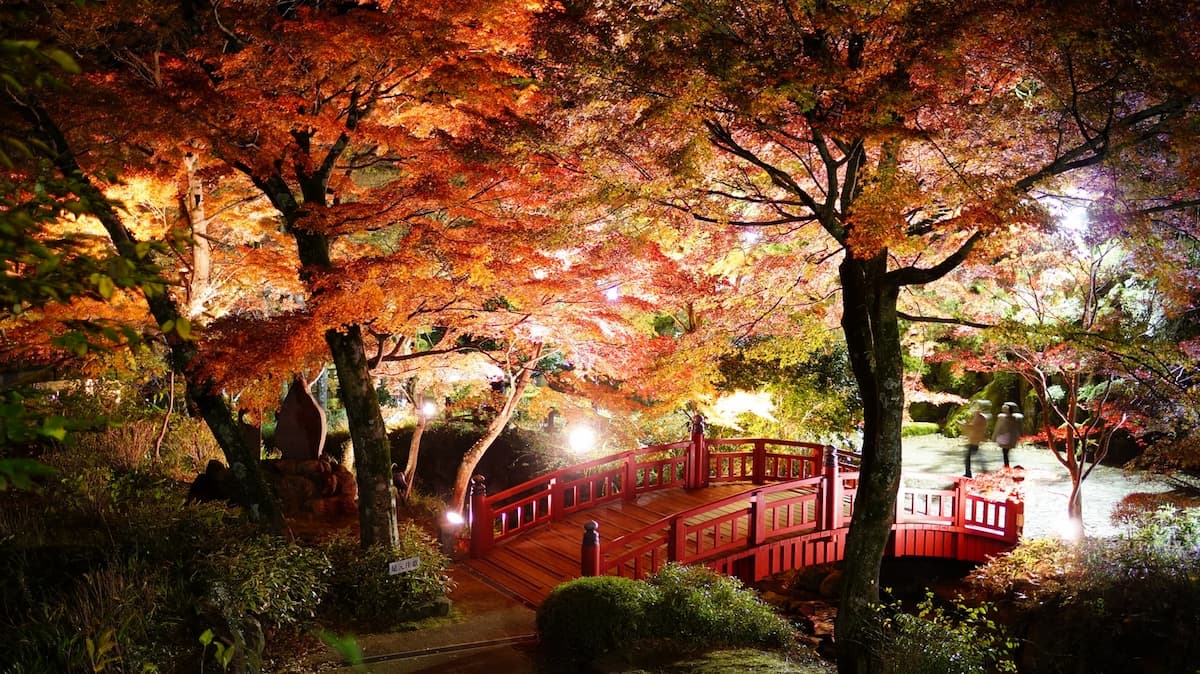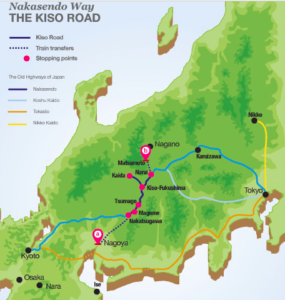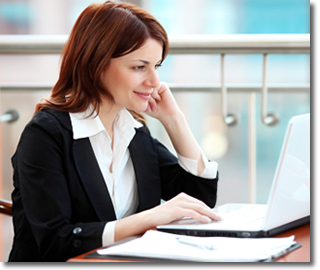
The Kiso Road, along the Nakasendo Way. For artists and writers. Nov 24-28, 2025.
In collaboration with our partner Walk Japan.
Our five day, four night, haiku walking tour focuses on the mid-section of this historical road between Kyoto and Tokyo — through the mountains and old post towns of central Japan. Beginning in Nagoya and ending in Matsumoto. Great walking through rural and mountainous countryside trails; staying in traditional inns, soaking in the onsen(communal baths), enjoying hearty farmhouse cuisine, writing haiku as we go.
The Kiso Road is a fully-guided tour suitable for anyone who is an occasional walker and can walk for more than four hours in comfort. In general, the route is gently undulating but also it includes some short, steeper climbs. The walking routes can be modified if need be.
Haiku workshops will take place before we set out in the mornings with prompts and exercises given on our walks. Encouraging an accessible and playful approach to this classic form we offer the workshops and exercises as a way of entering the present moment and inspiring a haiku way of life. There’s no pressure to produce perfect haiku poems, simply to enter into and enjoy the experience or apply to your sketching or photography practice. We will take our inspiration from the old masters of the art like Basho, Issa, Shiki, as well as modern western practitioners.
At the end of the day reading/sharing sessions take place before or during dinner and give an opportunity to reflect on our daily experience. Participants are encouraged to keep a creative journal (use A5 Vis diary) for collecting haiku observations, stamps, temple tickets, labels etc.

Itinerary and prices below.
GALLERY WRITING FROM PAST TRIPS EXPRESS INTEREST
Among those who once walked the Kiso Road were the famed haiku poet Matsuo Basho (1644-1694) who wrote many of his famous haiku poems while travelling this way and Utagawa Hiroshige (1797–1858), who in the late 1830s, he traveled along the Nakasendo highway, contributing 46 designs to a series of 69 views of this highway. His highway prints provide accurate representations of the roads, post-towns, pilgrims and travel methods of his day. Many of the scenes he depicted are still recognizable today. Scattered along the Nakasendo, at Shinchaya, Shimo-suwa, and Karuizawa, you can find rocks inscribed with poems. Composed by Basho, the poems evoke the local landscape at a particular time of year and are much appreciated by local residents who have erected the stone memorials to the poet.
Prices:
EARLY BIRD: $4790AUD. ($2985USD) PP Twin share. (Pay in full by April 30).
REGULAR: $4990 AUD ($3110USD). PP Twin share.
Limited singles. Single Supp $450 AUD($280USD).
Payments made in AUD at daily exchange rates at time of payment. Above USD is estimate.
Please send Expression of Interest ASAP to Jan here.
Or reserve your place with your $1500AUD deposit here.
Inclusions: Walk Japan tour leader; 4 nights’ accommodation; 4 breakfasts, 3 lunches and 4 evening meals; luggage transfers; entrance fees; travel from tour start point to tour finish point. Haiku workshops with tutor Jan Cornall, pre and post trip zoom meetings, publication online in our Medium online magazine, Summer Grass.
Exclusions: Airfares, travel insurance, personal extras. Travellers must have travel insurance.

Matsuo Basho
Basho was a master poet who developed what has come to be known as the haiku poem with its 5-7-5 syllable format, to a high level. He brought to haiku wit, brevity, and a degree of bawdiness which popularized the form among serious poets as well as those seeking entertainment while drinking or eating. Basho is also famous for his travelogues combining poetry and prose, recognised as great achievements in their genre. His journeys have been immortalized in works which combine poetry with diary: ‘The Records of a Travel-Worn Satchel’ and ‘A Visit to Sarashina Village’, both translated into English in 1966. And his most famous ‘The Narrow Road to the Deep North’.
Hiroshige
Hiroshige is the given name of Ando Hiroshige (1797-1858) who was a woodblock print artist and illustrator best known for his landscapes. His work was influenced by brush painting and ukiyoe (pictures of the ‘floating world’) which depicted the joys, sorrows and beauties of the entertainment districts. Woodblock prints of actors and courtesans were not particularly successful for Hiroshige, although they were immensely successful in the hands of other artists, but a series of landscape prints led to a commission in 1830 to do ten landscapes of Edo. Ultimately, he executed around 1,000 landscapes of this, his favorite city.

Vegetarians can be catered for however, due to the essential and widespread use of dashi stock throughout Japanese cooking, which typically uses fish, or other stock with meat as its base, Walk Japan is unable to provide strict vegetarian meals on tour. With advance notice via your booking form, our accommodation hosts will try to replace any fish or meat dishes with alternatives. Gluten free is more difficult. While it may be possible to omit certain items that obviously contain gluten, such as bread or noodles, it is impossible to provide fully gluten-free meals due to the use of certain staples that serve as the basis of so many dishes in Japanese cuisine. On our guided tours, your Walk Japan Tour Leader will explain the contents of all meals and help you avoid anything you may not wish to eat or should avoid. However, the Tour Leader or Walk Japan cannot take responsibility for what may or may not be in any particular dish.
ITINERARY
Haiku Walking in Japan, Nov 24-28, 2025.
Accommodation Traditional Japanese inn.
Meals: Lunch & dinner provided.
Total walking: 8km (5 miles).
Total elevation gain: 320m (1,148ft).
Today we begin by exploring Magome post town, birth-place of Shimazaki Toson, Japan’s first modern novelist and author of Before the Dawn. Perched on a hill and boasting grand views of the surrounding countryside, Magome retains a charming character despite increasing numbers of visitors. Leaving the town, we follow the way up the appropriately named Magome Pass and meander slowly downhill through the woods, passing a pair of historic waterfalls before we reach the small hamlet of O-tsumago and, about 20 minutes further on, the village of Tsumago itself.
Tsumago is the best preserved and arguably the most attractive of all the post towns. The inhabitants take great pride in their town and have banished telephone poles, electric lines and vending machines from the main street. We follow the old highway on, passing idyllic hamlets and fields, until it descends to the town of Nagiso. From here, a local train takes us to Kiso-Fukushima and our accommodation for the evening.
Accommodation: Traditional Japanese inn with onsen hot spring baths.
Meals: Breakfast, lunch & dinner provided.
Total walking: 13km (8.1 miles).
Total elevation gain: 520m (1,706ft).
Transfer part-way to the Kaida Plateau where our morning’s walk follows an ancient path over the Jizo Pass and then down onto the Kaida Plateau. The plateau is dominated by Mt. Ontake, an active volcano that is considered sacred by one esoteric Buddhist sect.
After lunch, our afternoon’s excursion takes us over another high pass that, on a clear day, provides views high over the plateau to Mt. Ontake. We descend from here to our accommodation, a delightful Japanese inn with onsen baths.
The duration and destination of our walk will depend on weather conditions. For tours in January through March there may be a chance to snowshoe, again dependent on weather conditions.
Accommodation: Traditional Japanese inn with onsen hot spring baths.
Meals: Breakfast, lunch & dinner provided.
Total walking: 14km (8.7 miles).
Total elevation gain: 673m (2,200ft).
Returning from the Kaida Plateau to Kiso Fukushima, we stroll through the town and visit the reconstructed barrier station that stood here during the Edo period. A short rail transfer then takes us to Yabuhara, where we begin our climb of the Torii Toge (Torii Pass). The pass is named after the Shinto torii gate that marks one of four protective sites surrounding the sacred Mt. Ontake. At 1,197 meters, the Torii Pass is also the second highest point on the Nakasendo. The descent into Narai post town takes us along narrow mountain paths until we emerge at the outskirts of this famous post-town next to a joyato stone night lantern.
We have some time to explore Narai before transferring by train to Matsumoto, set in Japan’s Central Alps on a plateau famous in Japan for its apples, grapes and wine. Our final night is spent here at a modern hotel, dining together at a restaurant in the city.
Accommodation: Western-style hotel.
Meals: Breakfast & dinner provided.
Total walking: 11km (6.8 miles).
Total elevation gain: 373m (1,220ft).
Express trains connect Matsumoto to Tokyo and Nagoya, where onward Shinkansen bullet trains speed to Kyoto. Your Walk Japan tour leader will be on hand to help you purchase your train tickets for your onward journey.
Accommodation: N/A.
Meals: Breakfast provided.
Total walking: 2km (1.2 miles).
Total elevation gain: N/A.
This itinerary is subject to change.
